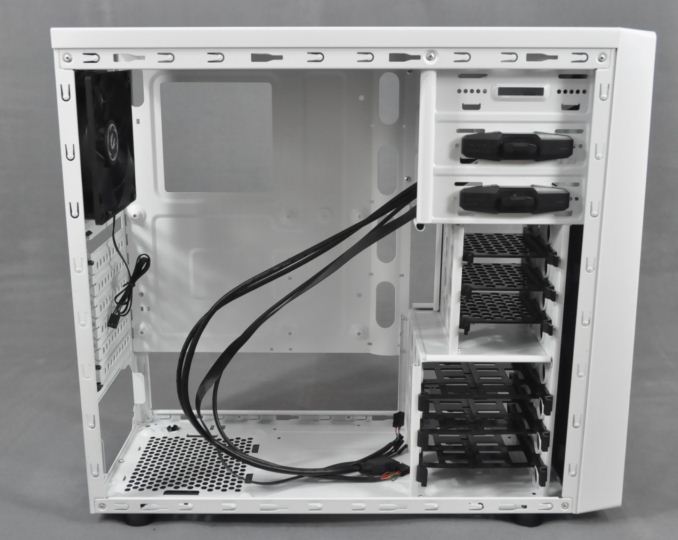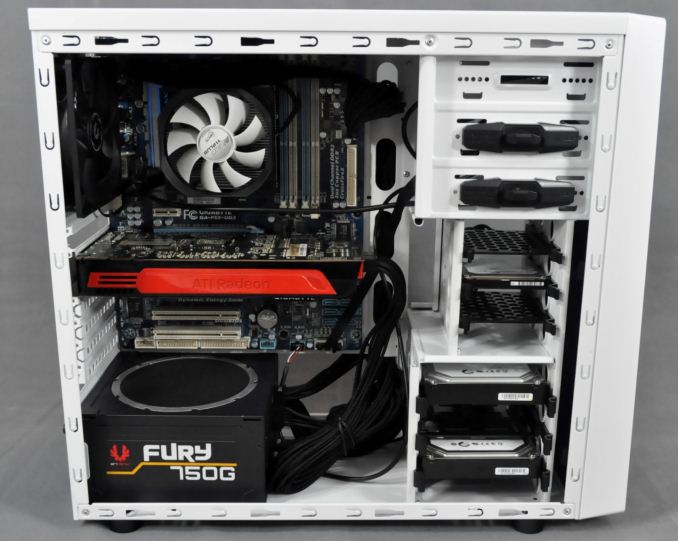BitFenix Neos Case Review
by E. Fylladitakis on January 21, 2015 9:00 AM EST- Posted in
- Cases/Cooling/PSUs
- bitfenix
- Case
BitFenix Neos Interior
The interior of the BitFenix Neos is relatively simple, nearly as much as a generic low cost Mid-Tower case. Everything inside the case is bolted together – no bays or metallic parts are removable. The motherboard tray is sizable enough for a typical ATX motherboard, with an opening behind the CPU area for the installation of CPU coolers.
Of course the size and location won't work for anyone with a motherboard that does not have its CPU socket right at the center of the upper left square area formed by the four screws, which will affect more than half of the motherboards available today, forcing the users to remove them in order to change the CPU cooler. On the other hand, those who rarely change out CPU coolers will be able to install the cooler before installing the motherboard. Note that the case is narrow as well, and CPU coolers taller than 150-155mm are not going to fit. Furthermore, instead of using brass motherboard stand-offs, the tray itself is embossed to form screw fixings for the motherboard. This can make assembly more convenient at times at the cost of some flexibility.
Across the right edge of the motherboard tray, there are four holes for the routing of cables. A fifth hole is present at the top left corner of the tray as well. None of these holes have any rubber grommets and all of them are barely large enough for an ATX 24-pin connector to fit. As there is virtually no clearance behind the motherboard tray for the routing of cables, the right section is elevated for the thick ATX cable to fit. Unfortunately, the use of a couple of PCI Express cables and SATA cables will require more than a little force to close the side panel.
There are three drive cages in the Neos. The top cage is for two 5.25" devices, which can be secured using the plastic locks. The middle cage is narrow, slightly increasing the clearance for one GPU card up to 310mm, and holds three trays for 2.5" devices. Finally, the bottom cage is for three 3.5" devices, but its trays can be used for 2.5" devices as well. For 3.5" devices, no tools are required, but in either case a screwdriver is necessary for the installation of a 2.5" drive.
The motherboard expansion slots are perhaps the greatest issue of the Neos. We have not seen the use of perforated non-reusable covers in a long time, but here they are, the removal of which is permanent and frequently leaves nasty dents behind. Above the expansion slots, the only stock fan of the case can be seen, a black 120mm fan. Take note that due to the narrowness of the case, there is no clearance to install a liquid cooling radiator wider than the fan itself here.
There is plenty of room for any kind of power supply, yet we advise against the installation of a unit longer than 160mm, as the fan opening is small and the displacement of the fan backwards will result in partial blockage, which is a problem with PSUs as it can leave critical components without sufficient cooling. The PSU sits on embossed metallic feet formed from the case panel itself. For this review, BitFenix supplied us one of their Fury 750G PSUs that has individually sleeved cables and is a perfect fit for the Neos.
As exhibited in the pictures of our test build, the interior of the BitFenix Neos is relatively comfortable to work with but can easily end up looking messy, as the cable management options are very limited. The only pathway for the routing of cables, to the right of the motherboard tray, becomes congested with just the thick 24-pin ATX cable going through it. The placement of the hole at the top left corner of the tray appears to have been done with little thought, as a typical motherboard blocks it entirely, leaving no room for a CPU power cable to fit through. There is enough space to comfortably work with the connectors and cables of the 2.5" and 3.5" drives though.
To summarize the component limitations once again, CPU coolers taller than 150mm are not recommended and a single 310mm GPU card may be installed. 160mm long PSUs are strongly advised. The radiators of AIO liquid cooling systems cannot be installed anywhere as well, and the routing options for cables are lacking. Given the price, these flaws could be overlooked provided the performance and other features prove desirable, so let's move on to our testing.


















54 Comments
View All Comments
YoloPascual - Wednesday, January 21, 2015 - link
Outclassed by the Corsair 100R.mischlep - Wednesday, January 21, 2015 - link
Minor typo, page 3: "nearly as much as a generic low cost Midi-Tower case"Should probably be a "Mid-Tower case"
mr_tawan - Wednesday, January 21, 2015 - link
This case might target digital musician :-).SleepModezZ - Wednesday, January 21, 2015 - link
'Midi tower' is a term in common use. It means the same as 'mid-tower' but is more used outside of US. The same tower cases that are classified as 'mid towers' on amazon.com are classified as 'midi tower' on amazon.co.uk. Even on amazon.com many descriptions calls a case a 'midi tower' although it is named a 'mid tower' in the big title. So maybe 'midi tower' is the proper term and 'mid tower' is what came of it after Americans butchered it?JarredWalton - Thursday, January 22, 2015 - link
For computer components, a large number of terms originated in the US market so we could hardly have "butchered" it, right? Anyway, given E. is located in Europe his use of "midi-tower" is completely acceptable, but for our US readers I went ahead and changed it to "mid-tower". Midi files... does anyone still use those? I remember back in the late 80s and early 90s where high quality Midi sound modules like the Roland MT-32 were the best way to listen to Midi. Good times! (And my MT-32 only cost about $600 all told. Ouch. So no, I don't miss those days.)SleepModezZ - Thursday, January 22, 2015 - link
You are right, I forgot to put a smiley after my last sentence.dragosmp - Wednesday, January 21, 2015 - link
I imagine a bottom-mounted extra fan would help quite a bit, but for the money they ask this case should be betterMurloc - Wednesday, January 21, 2015 - link
it's like they looked for a chinese factory that's not done a single upgrade since the 90s and made them make a case that looked decent.I mean, you could sell cases without expansion slot covers to PC companies that build computers which are not meant to be further tampered with, but if you're selling a case directly to users it needs to be a bit more future proof.
FriendlyUser - Wednesday, January 21, 2015 - link
Great review. I would suggest adding a 250W thermal load, corresponding to a mid-level machine with something like a 750Ti and a 65W CPU. Also, I would be curious to see when the case reaches equilibrium. I don't know if technical reasons require a failsafe cut-off, but I think you could maybe let it run up to 100C or try a cooler environment.SleepModezZ - Wednesday, January 21, 2015 - link
I would suggest an even lower thermal load to simulate systems that are not build for gaming. I have my computer in a quite similar sized case. Kill-a-watt shows that it is drawing 60 - 110 W. The idea of testing every case like it is meant to house a 850W or 400W gaming monster and then judge them based on their obvious failings is silly.The graphs compare the case to other better cases without mentioning that they are at least 50% bigger in size and probably also at least as much pricier. Those facts alone might make the Neos a better choice for those who are not planning to put in it anything even close to 850 or 400 Watts and wants a decent looking case . (Actually many cheap cases look really bad - they either look like toys for prepubertal boys or black and silver plastic cases for workplaces or people that do not care at all about the looks of the case.) The difference in thermal performance compared to to bigger and pricier gaming cases probably will not have any practical meaning when going to the sub 200 W range. The Neos is clearly not meant for gamers or overclockers so it should not be evaluated like such a case. The noisy fan is a real bummer but it could be replaced with a better fan, and there is place for 2 more 120mm fans on the front of the case if a bit better thermal performance should be needed. The only practical information in this review for someone like me who might actually consider this case, is that the metallic mesh might easily be damaged, that the expansion slot covers are what they are and I probably would have to change the fan for a less noisy. What about the HDD noise?